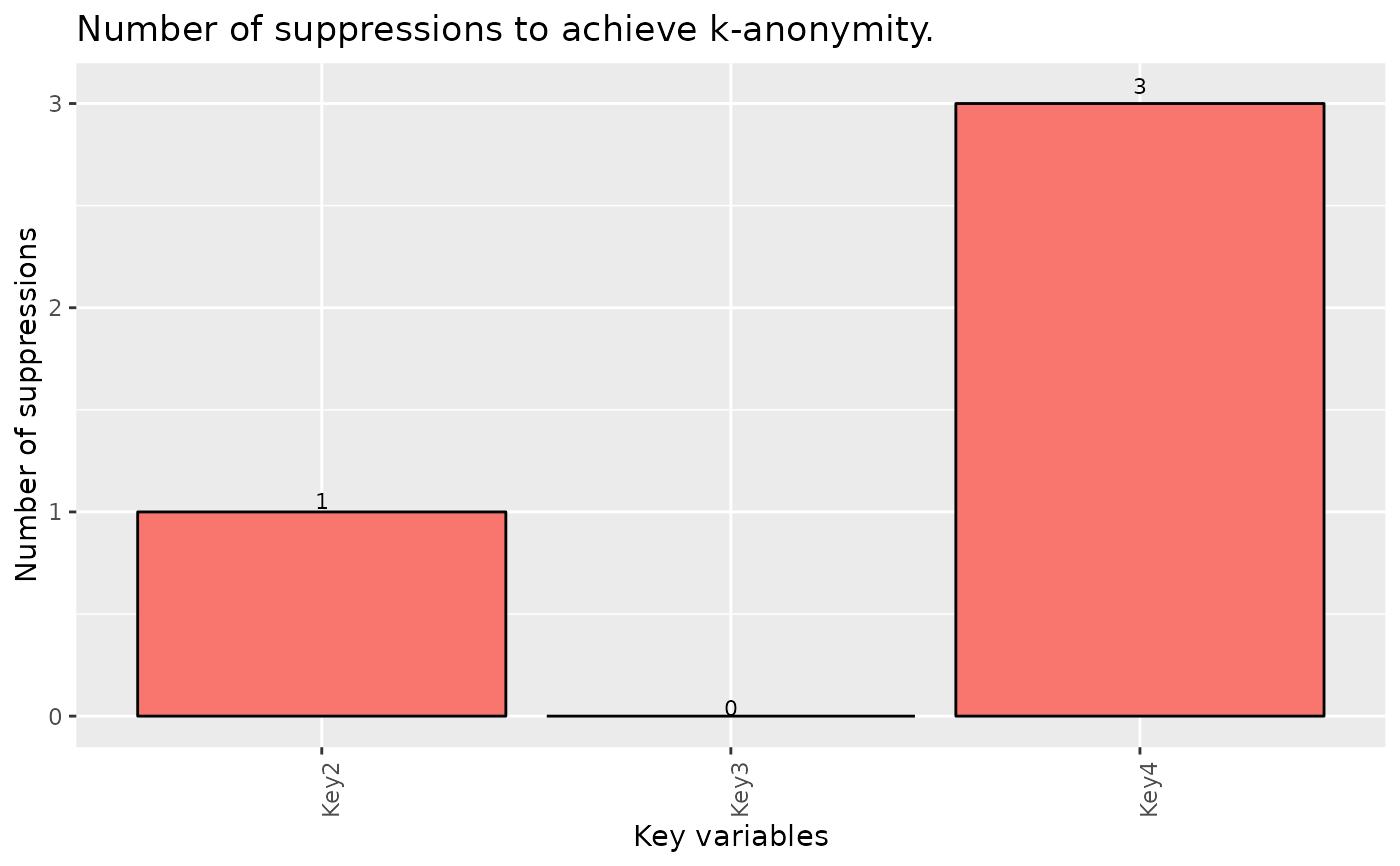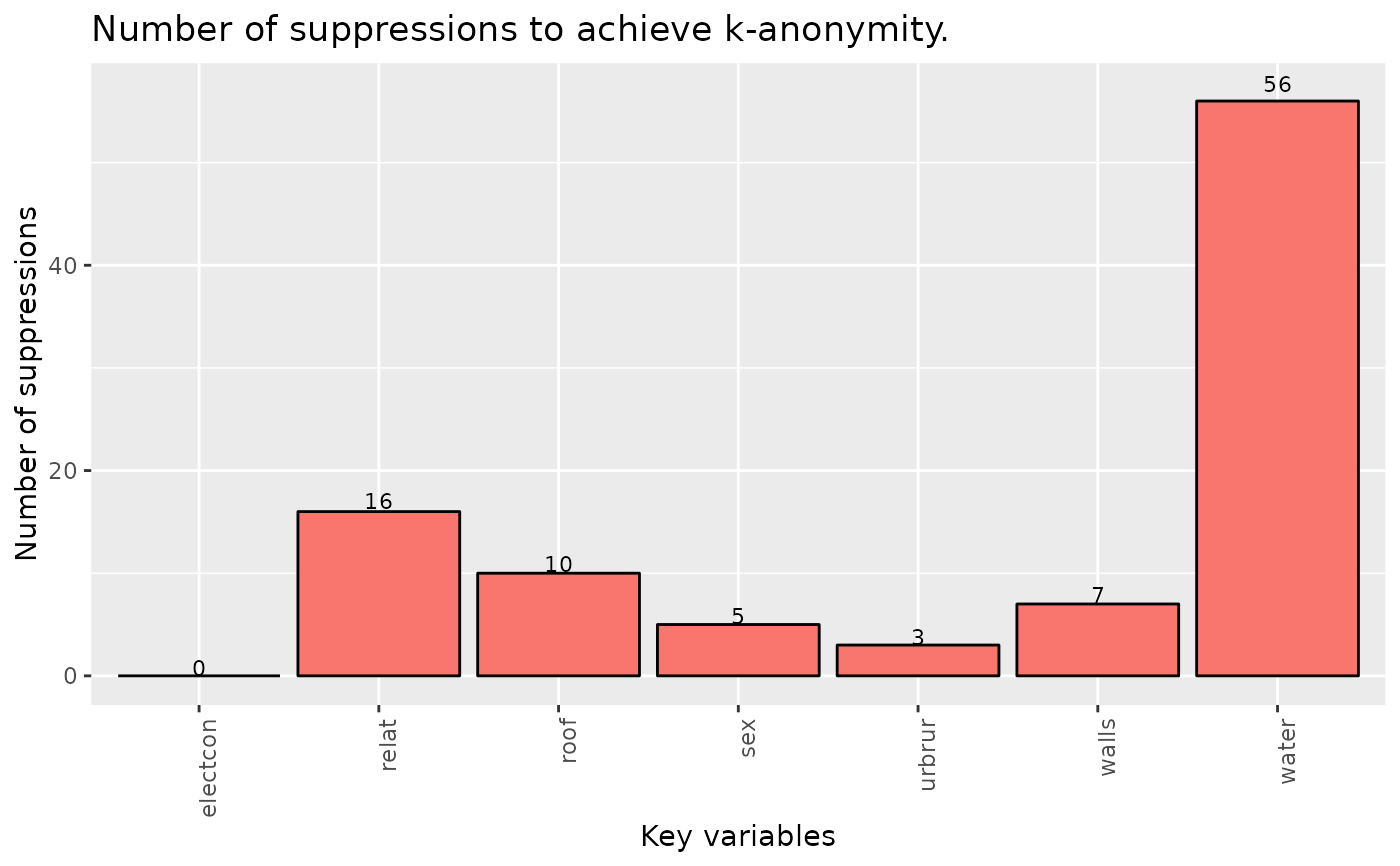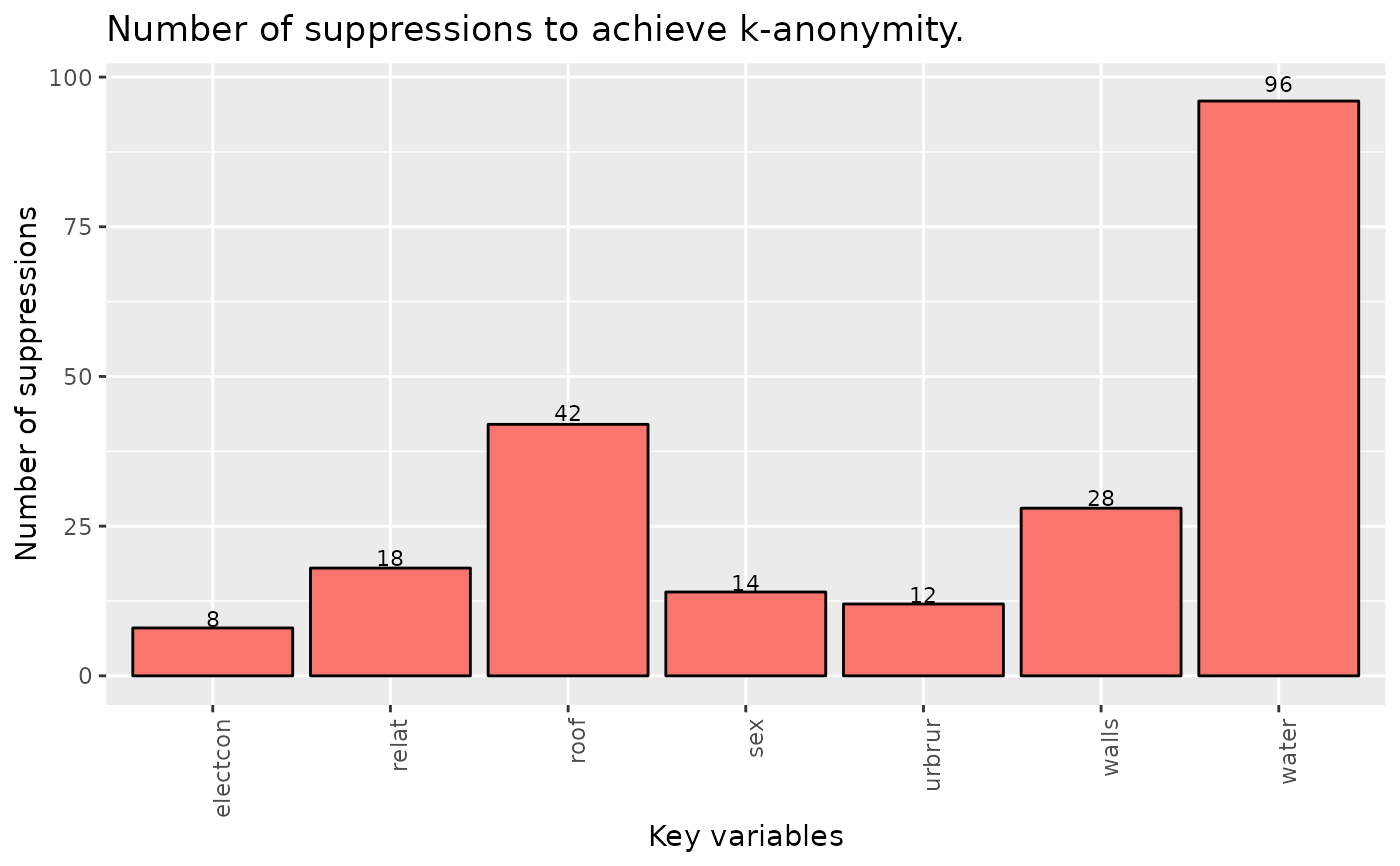Algorithm to achieve k-anonymity by performing local suppression.
localSuppression(obj, k = 2, importance = NULL, combs = NULL, ...)
kAnon(obj, k = 2, importance = NULL, combs = NULL, ...)Arguments
- obj
a
sdcMicroObj-classobject or adata.frame- k
Threshold for k-anonymity
- importance
Numeric vector of values between 1 and n (
n = length(keyVars)). This vector defines the "importance" of variables for local suppression. Variables withimportance = 1will, if possible, not be suppressed; variables withimportance = nwill be prioritized for suppression.- combs
Numeric vector. If specified, the algorithm provides k-anonymity for each combination of n key variables (with n being the value of the ith element of this parameter). For example,
combs = c(4,3)means that k-anonymity will be provided for all combinations of 4 and then 3 key variables. It is possible to assign different k values for each combination by supplyingkas a vector. Ifkhas only one value, it will be used for all subsets.- ...
see additional arguments below:
keyVars: Names or indices of categorical key variables (for data.frame method)strataVars: Name or index of the variable used for stratification. k-anonymity is ensured within each category of this variable.alpha: Numeric value between 0 and 1 specifying how much keys with missing values (NAs) contribute to the calculation offkandFk. Default is1. Used only in thedata.framemethod.nc: Maximum number of cores used for stratified computations. Default is1. Parallelization is ignored on Windows.
Value
A modified dataset with suppressions that meets k-anonymity based on
the specified key variables, or the modified sdcMicroObj-class object.
Details
The algorithm provides a k-anonymized data set by suppressing values in key variables. The algorithm tries to find an optimal solution to suppress as few values as possible and considers the specified importance vector. If not specified, the importance vector is constructed in a way such that key variables with a high number of characteristics are considered less important than key variables with a low number of characteristics.
The implementation provides k-anonymity per strata, if slot strataVar has
been set in sdcMicroObj-class or if parameter strataVar is
used when applying the data.frame method. For details, see the examples provided.
For the parameter alpha:
alpha = 1counts all wildcard matches (i.e.NAs match everything).alpha = 0assumes missing values form their own categories.
These are two extremes. With alpha = 0, frequencies are likely underestimated when
NAs are present. If combs is used with alpha = 0, the heuristic nature of kAnon()
may lead to technically correct, but not always intuitively understandable frequency evaluations.
Note
Deprecated methods localSupp2 and localSupp2Wrapper are no longer available
in sdcMicro versions > 4.5.0.
kAnon() is a more intuitive term for local suppression, since the goal is to achieve k-anonymity.
References
Templ, M. Statistical Disclosure Control for Microdata: Methods and Applications in R. Springer International Publishing, 287 pages, 2017. ISBN: 978-3-319-50272-4. doi:10.1007/978-3-319-50272-4
Templ, M., Kowarik, A., Meindl, B. Statistical Disclosure Control for Micro-Data Using the R Package sdcMicro. Journal of Statistical Software, 67(4), 1–36, 2015. doi:10.18637/jss.v067.i04
Examples
# \donttest{
data(francdat)
## Local Suppression
localS <- localSuppression(francdat, keyVar = c(4, 5, 6))
localS
#>
#> -----------------------
#> Total number of suppressions in the key variables: 4 (new: 4)
#>
#> Number of suppressions by key variables:
#> (in parenthesis, the total number suppressions is shown)
#>
#> Key2 Key3 Key4
#> 1 1 (1) 0 (0) 3 (3)
#>
#> 2-anonymity == TRUE
#> -----------------------
plot(localS)
 ## for objects of class sdcMicro, no stratification
data(testdata2)
kv <- c("urbrur", "roof", "walls", "water", "electcon", "relat", "sex")
sdc <- createSdcObj(testdata2, keyVars = kv, w = "sampling_weight")
sdc <- localSuppression(sdc)
## for objects of class sdcMicro, with stratification
testdata2$ageG <- cut(testdata2$age, 5, labels = paste0("AG", 1:5))
sdc <- createSdcObj(
dat = testdata2,
keyVars = kv,
w = "sampling_weight",
strataVar = "ageG"
)
sdc <- localSuppression(sdc, nc = 1)
## it is also possible to provide k-anonymity for subsets of key-variables
## with different parameter k!
## in this case we want to provide 10-anonymity for all combinations
## of 5 key variables, 20-anonymity for all combinations with 4 key variables
## and 30-anonymity for all combinations of 3 key variables.
sdc <- createSdcObj(testdata2, keyVars = kv, w = "sampling_weight")
combs <- 5:3
k <- c(10, 20, 30)
sdc <- localSuppression(sdc, k = k, combs = combs)
## data.frame method (no stratification)
inp <- testdata2[, c(kv, "ageG")]
ls <- localSuppression(inp, keyVars = 1:7)
print(ls)
#>
#> -----------------------
#> Total number of suppressions in the key variables: 97 (new: 97)
#>
#> Number of suppressions by key variables:
#> (in parenthesis, the total number suppressions is shown)
#>
#> urbrur roof walls water electcon relat sex
#> 1 3 (3) 10 (10) 7 (7) 56 (56) 0 (0) 16 (16) 5 (5)
#>
#> 2-anonymity == TRUE
#> -----------------------
plot(ls)
## for objects of class sdcMicro, no stratification
data(testdata2)
kv <- c("urbrur", "roof", "walls", "water", "electcon", "relat", "sex")
sdc <- createSdcObj(testdata2, keyVars = kv, w = "sampling_weight")
sdc <- localSuppression(sdc)
## for objects of class sdcMicro, with stratification
testdata2$ageG <- cut(testdata2$age, 5, labels = paste0("AG", 1:5))
sdc <- createSdcObj(
dat = testdata2,
keyVars = kv,
w = "sampling_weight",
strataVar = "ageG"
)
sdc <- localSuppression(sdc, nc = 1)
## it is also possible to provide k-anonymity for subsets of key-variables
## with different parameter k!
## in this case we want to provide 10-anonymity for all combinations
## of 5 key variables, 20-anonymity for all combinations with 4 key variables
## and 30-anonymity for all combinations of 3 key variables.
sdc <- createSdcObj(testdata2, keyVars = kv, w = "sampling_weight")
combs <- 5:3
k <- c(10, 20, 30)
sdc <- localSuppression(sdc, k = k, combs = combs)
## data.frame method (no stratification)
inp <- testdata2[, c(kv, "ageG")]
ls <- localSuppression(inp, keyVars = 1:7)
print(ls)
#>
#> -----------------------
#> Total number of suppressions in the key variables: 97 (new: 97)
#>
#> Number of suppressions by key variables:
#> (in parenthesis, the total number suppressions is shown)
#>
#> urbrur roof walls water electcon relat sex
#> 1 3 (3) 10 (10) 7 (7) 56 (56) 0 (0) 16 (16) 5 (5)
#>
#> 2-anonymity == TRUE
#> -----------------------
plot(ls)
 ## data.frame method (with stratification)
ls <- kAnon(inp, keyVars = 1:7, strataVars = 8)
print(ls)
#>
#> -----------------------
#> Total number of suppressions in the key variables: 109 (new: 109)
#>
#> Number of suppressions by key variables and strata:
#> (in parenthesis, the total number suppressions is shown)
#>
#> urbrur roof walls water electcon relat sex
#> AG5 1 (1) 2 (2) 1 (1) 1 (1) 1 (1) 1 (1) 1 (1)
#> AG3 2 (2) 3 (3) 3 (3) 7 (7) 0 (0) 2 (2) 0 (0)
#> AG1 0 (0) 10 (10) 5 (5) 24 (24) 0 (0) 3 (3) 5 (5)
#> AG2 2 (2) 5 (5) 3 (3) 13 (13) 2 (2) 2 (2) 1 (1)
#> AG4 1 (1) 1 (1) 2 (2) 3 (3) 1 (1) 1 (1) 0 (0)
#> Total 6 (6) 21 (21) 14 (14) 48 (48) 4 (4) 9 (9) 7 (7)
#>
#> 2-anonymity == TRUE in all strata!
#> -----------------------
plot(ls)
## data.frame method (with stratification)
ls <- kAnon(inp, keyVars = 1:7, strataVars = 8)
print(ls)
#>
#> -----------------------
#> Total number of suppressions in the key variables: 109 (new: 109)
#>
#> Number of suppressions by key variables and strata:
#> (in parenthesis, the total number suppressions is shown)
#>
#> urbrur roof walls water electcon relat sex
#> AG5 1 (1) 2 (2) 1 (1) 1 (1) 1 (1) 1 (1) 1 (1)
#> AG3 2 (2) 3 (3) 3 (3) 7 (7) 0 (0) 2 (2) 0 (0)
#> AG1 0 (0) 10 (10) 5 (5) 24 (24) 0 (0) 3 (3) 5 (5)
#> AG2 2 (2) 5 (5) 3 (3) 13 (13) 2 (2) 2 (2) 1 (1)
#> AG4 1 (1) 1 (1) 2 (2) 3 (3) 1 (1) 1 (1) 0 (0)
#> Total 6 (6) 21 (21) 14 (14) 48 (48) 4 (4) 9 (9) 7 (7)
#>
#> 2-anonymity == TRUE in all strata!
#> -----------------------
plot(ls)
 # }
# }